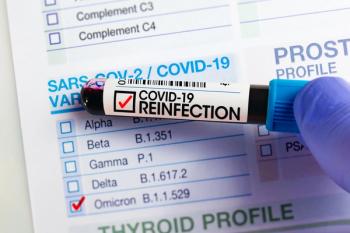
- July 2022
- Volume 88
- Issue 7
Controlling Blood Sugar Benefits Heart Health
Women, in particular, suffer more severe cardiovascular and other complications related to diabetes.
More than 34 million Americans have diabetes and 88 million have prediabetes, many of whom do not even know it, according to the CDC. This results in direct health care costs of more than $235 billion per year and $90 billion in lost productivity.1
Although more men are diagnosed with diabetes than women, diabetes affects women differently, and women often suffer more serious complications, which is why controlling blood sugar levels is essential.2
Symptoms
Many symptoms of diabetes are the same for men and women, such as blurred vision, excessive hunger or thirst, fatigue, frequent urination, fruity smelling breath, headaches, lower respiratory tract and urinary tract infections, recurrent skin conditions, slow-healing wounds, and unexplained weight loss. Women, however, often present with decreased libido, oral and/or vaginal yeast infections, and polycystic ovary syndrome.3,4
Risk Factors
Several factors increase the risk of women developing diabetes. These include belonging to certain ethnic- ities or races, such as being Asian American, African American, Native Alaskan, Native American, or Pacific Islander; being obese or overweight; being older than 45 years; having a family history of diabetes; having developed gestational diabetes during pregnancy; having high blood pressure and/or high cholesterol; having a history of heart disease or stroke; having polycystic ovary syndrome; and leading a sedentary lifestyle.3
Complications
Although women experience many of the same complications as men, such as diabetic retinopathy, food damage, heart and kidney disease, and neuropathy, they also experience different and/or more significant complications. These include the following:
Heart disease. The most common complication of diabetes is heart disease. Although men with diabetes develop heart disease at approximately twice the rate of those without diabetes, women develop heart disease at 4 times the rate. They also have worse outcomes than men after a heart attack.2
Hormonal changes. Women of child-bearing age experience hormonal changes every month. These changes make regulating blood glucose difficult. The same is true during pregnancy and progresses through menopause. As blood glucose levels increase, libido decreases. High blood glucose also results in vaginal dryness, making intercourse uncomfortable and even painful.2
Pregnancy. Diabetes can cause prob- lems for both mother and child during pregnancy. Poor glucose control during pregnancy can increase the risk of breathing problems, low blood glucose at birth, birth defects, and premature delivery and may also cause the baby to weigh too much, causing delivery complications. Women with diabetes generally have a harder time becoming pregnant. They also have a higher risk of developing preeclampsia or having a caesarian section, miscarriage, or stillbirth.2
Urinary tract and yeast infections. Decreased circulation and excess blood glucose levels conspire to reduce the body’s ability to fight infection. This can lead to recurrent oral and vaginal yeast infections, as well as urinary tract infections. Additionally, many women with diabetes have bladders that do not empty completely, creating a welcoming environment for bacteria to grow.2
Gestational Diabetes
Gestational diabetes develops when a woman who does not have diabetes experiences high blood glucose levels during pregnancy. This occurs in approximately 2% to 10% of pregnancies in the United States each year. Gestational diabetes can happen to any woman, but the risk is greater when a woman has a family history of type 2 diabetes, is obese or overweight, or is older than 25 years.2
Gestational diabetes usually resolves after giving birth; however, approximately 50% of these women go on to develop type 2 diabetes. It is important to retest for diabetes between 4 and 12 weeks after delivery, then every 1 to 3 years thereafter.2
What Women Can Do
The goal with diabetes for both men and women is to keep hemoglobin A1c and blood glucose levels at or below target levels. Because diabetes is not a one-size-fits-all disease, disease management is different based on the individual, although the mechanisms used are the same. Management includes proper diet, exercise, hydration, medications, avoiding alcohol and smoking, and appropriate planning.5
Women also have some special circumstances that require extra effort. What follows are some things to keep in mind:
Diet. Patients should know how different foods affect the body. Counting carbohydrates, coordinating meals and medications, and choosing the right food combinations for well-balanced meals are all important in managing diabetes.5
Exercise. Patients should talk to a clinician about an exercise plan, keep an exercise schedule, and know the ideal blood glucose level to have before beginning exercise.5
Medications. Patients should know which medications are taken and when and adhere to the schedule. They should also understand the proper storage of medications; insulins are kept in the refrigerator, for example. Patients should report any problems with medications to a pharmacist or physician. They should also be careful with new medications because some can affect blood glucose levels.5
Plan ahead. It is of the utmost importance to be prepared when managing diabetes. Patients should always have enough medication on hand. If a medication is the difference between life and death, they should make sure there is enough to cover emergency situations that may arise and have
a plan to transport medication safely. They should also have a plan for when illness occurs. The body’s defense mechanisms that help fight off illness can also raise blood glucose levels. Illness may also affect appetite, making glucose control that much harder. Patients should test often when an illness strikes and adjust management accordingly.5
Women’s special circumstances. Hormone levels fluctuate before, during, and after a menstrual cycle. It is important to be proactive and try to distinguish patterns in blood glucose changes that correlate with hormonal changes. Adjustments to a diabetic treatment plan may be necessary during these times to keep glucose low. Additionally, the same is true for pregnancy and menopause, although these may be more gradual and longer term.5
About The Author
Kathleen Kenny, PharmD, RPh, has more than 25 years of experience as a community pharmacist. She is a freelance clinical medical writer based in Homosassa, Florida.
References
1. Division of diabetes translation at a glance. CDC. Updated August 21, 2020. Accessed June 13, 2022. https://www.cdc.gov/chronicdisease/resources/publications/aag/diabetes.htm
2. Diabetes and women. CDC. Updated December 1, 2020. Accessed June 13, 2022. https://www.cdc.gov/diabetes/library/ features/diabetes-and-women.html
3. Gotter A. How diabetes affects women: symptoms, risks, and more. Healthline. April 27, 2017. Accessed June 13, 2022. https://www.healthline.com/health/diabetes/ symptoms-in-women
4. Livadas S, Angnostis P, Bodou JK, Bantouna D, Paparodis R. Polycystic ovary syndrome and type-2 diabetes mellitis: a state-of-the-art review. World J Diabetes. 2022;13(1):5-26. doi:10.4239/wjd.v13.i1.5
5. Diabetes management: how lifestyle, daily routine affect blood sugar. Mayo Clinic. June 3, 2022. Accessed June 14, 2022. https://www.mayoclinic.org/diseases-conditions/ diabetes/in-depth/diabetes-management/art-20047963
Articles in this issue
over 3 years ago
National Practitioner Data Bank Aims to Reduce Malpracticeover 3 years ago
Pet Peeves: July 2022over 3 years ago
July 2022: Generic Product Newsover 3 years ago
Pharmacists Can Help Manage Patients With Parkinson Diseaseover 3 years ago
Quviviq From Idorsia Pharmaceuticalsover 3 years ago
OTC Case Studies: Rhinitisover 3 years ago
July 2022: Rx Product Newsover 3 years ago
Know Your Salary Rangeover 3 years ago
Help Patients Use Inhalers Properlyover 3 years ago
Illinois Legislature Empowers PharmacistsNewsletter
Stay informed on drug updates, treatment guidelines, and pharmacy practice trends—subscribe to Pharmacy Times for weekly clinical insights.


















































































































































































































